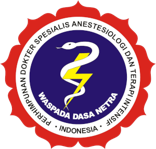Perioperative Management of Sectio Caesarea Surgery in Patient With Heart Valve Disorders
Abstract
Cardiovascular disease in pregnancy is common range from 1% to 3 and contributes to 10-15% of maternal mortality. Valvular heart disease accounts for about 25% of cases of cardiac complications in pregnancy and important cause of maternal mortality, some of which are mitral stenosis and mitral regurgitation. Cesarean delivery remains the preferred choice, as it reduces the hemodynamic changes that can occur in normal delivery and allows for better monitoring and hemodynamic management. Our paper provide in-depth information regarding the pathophysiology of heart valve disease in pregnant women and an appropriate perianesthesia approach to obtain a good prognosis. We report a case of a 26-year-old pregnant woman, with obstetric status G1P0A0, 36 weeks’ gestation, body weight 61 kg accompanied by severe mitral regurgitation and moderate mitral stenosis. This patient was planned to undergo elective cesarean section. The patient's condition in the perioperative examination was: GCS E4V5M6, other vital signs within normal limits, SpO2 98-99% in supine position. Other physical and laboratory examinations were also within normal limits. The goal of anesthesia during surgery in patients with heart valve disease undergoing cesarean section maintain pulmonary capillary pressure to prevent acute pulmonary edema. In this case, regional anesthesia of epidural anesthesia was chosen because it can reduce systemic vascular resistance and provide better post-cesarean section pain. The patient's hemodynamics perianesthesia tended to be stable without any complications such as pulmonary edema.
Keywords
Full Text:
PDFReferences
REFERENCE 1. Talbot L. Physiology of pregnancy. Anaesth Intensive Care Med [Internet]. 2016; Available from: http://dx.doi.org/10.1016/j.mpaic.2016.04.010 2. Anthony J, Osman A, Sani MU. Valvular heart disease in pregnancy. Cardiovasc J Afr. 2016;27(2):111–8. 3. Arendt KW, Lindley KJ. Obstetric Anesthesia Management of the Patient with Cardiac Disease. Int J Obstet Anesth [Internet]. 2018; Available from: https://doi.org/10.1016/j.ijoa.2018.09.011 4. Iqbal MA, Gupta M. Cardiogenic Pulmonary Edema. StatPearls. 2020. 5. Sciscione AC, Ivester T, Largoza M, Manley J, Shlossman P, Colmorgen GHC. Acute pulmonary oedema in pregnancy. Obstet Gynaecol Forum. 2017;27(2):4–9. 6. Righini M, Robert-EH, Le GG. Diagnosis of acute pulmonary embolism. 2017;1251–61. 7. Brown ML, Dinardo JA. Post-Operative Outcomes in Children With and Without Congenital Heart Disease Undergoing Noncardiac Surgery. 2016;67(7). 8. Sen S, Chatterjee S, Mazumder P, Mukherji S. Epidural anesthesia: A safe option for cesarean section in parturient with severe pulmonary hypertension. J Nat Sci Biol Med. 2016;7(2):182–5. 9. Rehatta NM, Hanindito E, Tantri AR, Redjeki IS, Soenarto RF, Bisri DY, et al. Anestesiologi dan Terapi Intensif: Buku Teks KATI-PERDATIN. 1st ed. Jakarta: PT. Gramedia Pustaka Utama; 2019. 617 p. 10. Heppolette CAA, Brunnen D, Bampoe S, Odor PM. Clinical Pharmacokinetics and Pharmacodynamics of Levobupivacaine [Internet]. Clinical Pharmacokinetics. Springer International Publishing; 2020. Available from: https://doi.org/10.1007/s40262-020-00868-0 11. El-Shaarawy A, Asfour M, Rashwan D, Amer M, El-Menshawe S, Elkomy M. Comparison of three different concentrations of levobupivacaine for epidural labor analgesia: Clinical effect and pharmacokinetic profile. Anesth Essays Res. 2018;12(1):60. 12. Attri J, Kaur G, Kaur S, Kaur R, Mohan B, Kashyap K. Comparison of levobupivacaine and levobupivacaine with fentanyl in infraumbilical surgeries under spinal anaesthesia. Anesth Essays Res. 2015;9(2):178. 13. Behzadi M, Joukar S, Beik A. Opioids and cardiac arrhythmia: A literature review. Med Princ Pract. 2018;27(5):401–14. 14. Soma-pillay P, Nelson-piercy C, Tolppanen H, Mebazaa A. Physiological changes in pregnancy. Cardiovasc J Afr. 2016;27(2):89–94. 15. Willfurth I, Baik-schneditz N. Cerebral Oxygenation in Neonates Immediately after Cesarean Section and Mode of Maternal Anesthesia. 2019; 16. Sümpelmann R, Becke K, Zander R, Witt L. Perioperative fluid management in children: Can we sum it all up now. Curr Opin Anaesthesiol. 2019;32(3):384–91. 17. Davis PJ, Cladis FP. Smith’s Anesthesia for Infants and Children. 9th ed. Philadelphia: Elsevier; 2017. 1131–1333 p. 18. Miao F, Feng K, Feng X, Fan L, Lang Y, Duan Q. The Analgesic Effect of Different Concentrations of Epidural Ropivacaine Alone or Combined With Sufentanil in Patients After Cesarean Section. 2021;12(February):1–9.
Refbacks
- There are currently no refbacks.








